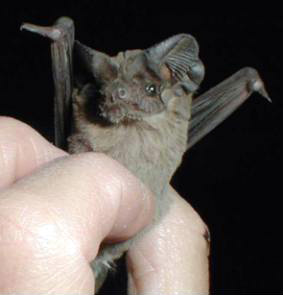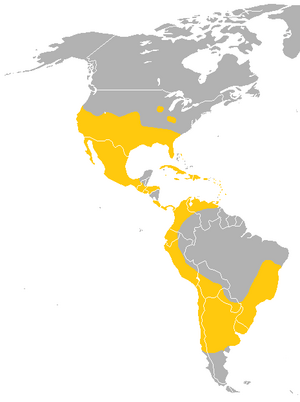Mexican free-tailed bat facts for kids
Quick facts for kids Mexican free-tailed batTadarida brasiliensis |
|
|---|---|
 |
|
| Conservation status | |
| Scientific classification | |
| Genus: |
Tadarida
|
| Species: |
brasiliensis
|
| Subspecies | |
|
|
 |
|
| Range of the Mexican free-tailed bat | |
The Mexican free-tailed bat (Tadarida brasiliensis) is a super interesting type of bat. You might also hear it called the Brazilian free-tailed bat. These amazing creatures live naturally in North and South America.
Contents
What Does a Mexican Free-tailed Bat Look Like?
Mexican free-tailed bats are usually about 9 cm (3.5 inches) long. That's about the length of a crayon! They weigh around 7–12 grams (0.25–0.42 ounces). This is like the weight of a few grapes.
Female bats are often a little heavier than males. Their ears are wide, rounded, and quite big compared to their heads. They use these large ears to help them find food. They do this by using echolocation, which is like sending out sound waves and listening for the echoes. Their wings are long and narrow, with pointed tips. The color of their fur can be dark brown or gray.
Where Do Mexican Free-tailed Bats Live?
You can find Mexican free-tailed bats from the southern United States all the way through Mexico. They also live across most of Central America and into South America. You can even find them in the Caribbean islands. They live in all of the Greater Antilles and 11 of the Lesser Antilles.
The biggest known group of these bats lives at Bracken Cave in Texas. Nearly 20 million bats call this cave home! That's an incredible number of bats living together.
Bat Homes: Caves and Buildings
Mexican free-tailed bats mostly live in caves. But they can also live in buildings. They just need easy ways to get in and out. They also need dark, hidden spots in ceilings or walls to rest.
How Mexican Free-tailed Bats Travel
Many of these bats travel long distances. Bats from places like southeastern Nevada and western Arizona fly southwest. They go to southern California and Baja California for warmer weather.
Other bats from places like southeastern Utah and western New Mexico travel south. They fly through the western part of the Sierra Madre Oriental mountains in Mexico. In the summer, some bats from Kansas and Texas also fly south to warmer parts of Texas and Mexico.
What Do Mexican Free-tailed Bats Eat?
Mexican free-tailed bats are mainly insectivores. This means they love to eat insects! They hunt their prey using echolocation, just like a sonar system.
They eat many different kinds of insects. Their favorite foods include moths, beetles, dragonflies, flies, true bugs, wasps, and ants. They usually catch flying insects while they are flying themselves.
Who Hunts Mexican Free-tailed Bats?
Mexican free-tailed bats have many different animals that hunt them. These include birds like red-tailed hawks, American kestrels, great horned owls, barn owls, and Mississippi kites.
Other animals that might try to catch them are Virginia opossums, striped skunks, and raccoons. Even some snakes like eastern coachwhips and eastern coral snakes might try to eat them.
How Mexican Free-tailed Bats Behave
Mexican free-tailed bats are nocturnal animals. This means they are active at night. They start looking for food after dusk, when the sun goes down. They can travel as far as 50 km (about 31 miles) to find food.
These bats can fly very high, sometimes around 3300 meters (over 10,000 feet) in the air! They are most active in the late morning and afternoon between June and September.
Images for kids
-
Mexican free-tailed bats, emerging from Carlsbad Caverns, Carlsbad Caverns National Park, New Mexico
See also
 In Spanish: Murciélago de cola libre para niños
In Spanish: Murciélago de cola libre para niños






